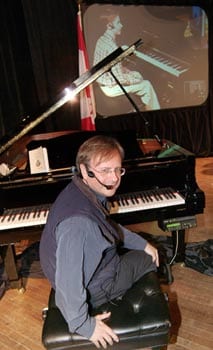Disklavier and Software Makes Real Time Long Distance Learning Possible

13-year old Nova Scotia resident Lucas Porter studies in real time with piano teacher Marc Durand, who is based 1,000 miles away at Toronto's Royal Conservatory of Music.
|
This type of groundbreaking interaction has been successfully repeated numerous times over the past two years thanks to the now patent-pending MusicPath software. Assisted by Karen Wilder, project manager and IT integrator, and Professor John Hansen, Chair, School of Music, Acadia University, the software was developed by Dr. Christoph Both and Dr. Jim Diamond, both of Acadia University, in partnership with Yamaha Canada Music Ltd. and The Royal Conservatory of Music, and with substantial funding from CANARIE Inc.
"MusicPath will work with any MIDI device," says Diamond. “But for the highest quality, one would want a Disklavier.”
Fully functional over high-speed networks, DSL or even dial-up, the MusicPath software is run from a single CD at each location, using Yamaha Disklavier pianos connected to an IP network via an intuitive, plug-and-play computer interface. MusicPath is usually paired with a video-conferencing system so musicians and can see and speak with one another, as well as collaborate musically in real time. In November 2004, two jazz pianists played together between the Halifax World Trade Center and George Mason University in Virginia, one hand performing in Canada and the other in the U.S. MusicPath also allows one pianist to play several pianos in real time: the result is an impressive new learning dimension for teachers, institutions and musicians, and the virtual elimination of geographic barriers.
In February 2004, at the first media event using Disklaviers in Acadia and RCM, "the public reaction was astounding," says Karen Wilder. "Oscar Peterson was in the audience, and he said he wished he had been able to learn this way from some of his idols."
The project also garnered considerable coverage from the media, including features in The New York Times and on the Discovery and Tech TV channels. Other demonstrations have linked Disklaviers at Acadia with ones in far-flung places like Virginia, Maine, Texas, Hawaii and even Germany, where the team was one of only ten Canadian groups invited by Industry Canada and the Canadian Embassy to take part in CeBIT, the world’s largest IT and software fair. Acadia University was recently honored by the Smithsonian Institute in Washington for its work in this area.
More information about MusicPath can be found at http://musicpath.acadiau.ca.
For more information on Yamaha products, write Yamaha Corporation of America, P.O. Box 6600, Buena Park, CA 90622; telephone (714) 522-9011; or e-mail infostation@yamaha.com.
 |
| © 2010 Yamaha Corporation of America. All rights reserved. |
